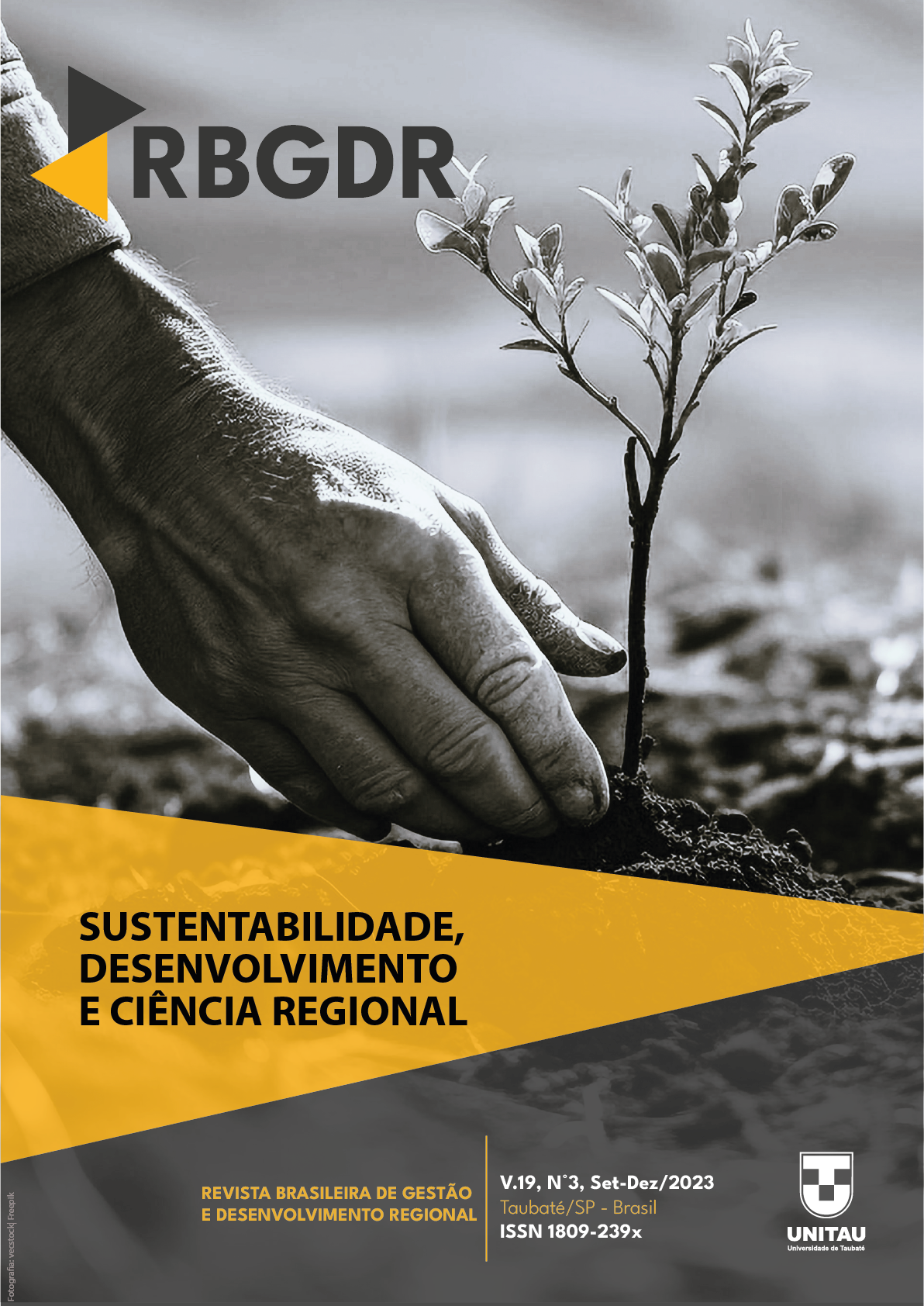ANÁLISE DE ESTRUTURA DE REDES DE INOVAÇÃO: O CASO DO PROGRAMA DE INOVAÇÃO TECNOLÓGICA (INOVAFIT)
DOI:
https://doi.org/10.54399/rbgdr.v19i3.5729Palabras clave:
Políticas de Ciência, Tecnologia e Inovação, Ciência, Capital humano, tecnológico e industrial Tecnologia e Sociedade,Resumen
Dentro de um contexto de fomento à inovação em Pequenas e Médias Empresas (PMEs), esta pesquisa teve como objetivo revelar características estruturais, assim como suas implicações, de uma rede de inovação baseada em projetos de inovação de empresas fomentados por programa de agência governamental. Para tanto, procedeu-se à análise de redes usando como base interações Empresa-Universidade-Instituto de Pesquisa (EUI) sob a perspectiva da Hélice Tríplice. Os resultados apontam para uma configuração de estrutura livre de escala com elevado agrupamento e reduzida distância conectiva entre os atores, além de apego preferencial das empresas a alguns poucos hubs, representados por universidades que exibem forte poder de centralidade na rede. Essa estrutura pode levar a uma maior redundância de conhecimento, bem como a uma maior velocidade de difusão e uma maior distribuição do conhecimento na rede. Algumas das contribuições centrais do trabalho está no desmembramento de universidades e institutos de pesquisa para análise do papel de cada ator institucional, além da realização de estudo empírico de rede local de projetos empreendidos por PMEs, bem como na oferta de insights que podem ajudar as ações da agência de fomentoCitas
ANGELINI, P.; CERULLI, G.; CECCONI, F.; MICELI, M.-A.; POTÌ, B. R&D subsidization effect and network centralization: evidence from an agent-based micro-policy simulation. J. of Artificial Societies and Social Simulation, v. 20, n. 4, 2017.
BARABÁSI, A.-L. Scale-free networks: a decade and beyond. Science, v. 325, n. 5939, p. 412-413, 2009.
BARABÁSI, A.-L.; ALBERT, R. Emergence of scaling in random networks. Science, v. 286, n. 5439, p. 509-512, 1999.
BARABÁSI, A.-L.; BONABEAU, E. Scale-free networks. Scientific American, v. 288, n. 5, p. 60-69, 2003.
BARRIE, J.; ZAWDIE, G.; JOíO, E. Assessing the role of triple helix system intermediaries in nurturing an industrial biotechnology innovation network. J. of Cleaner Production, v. 214, p. 209-223, 2019.
BREM, A.; RADZIWON, A. Efficient Triple Helix collaboration fostering local niche innovation projects – A case from Denmark. Techn Forecasting & Social Change, v. 123, p. 130-141, 2017.
CHEN, S.-H.; LIN, W.-T. The dynamic role of universities in developing an emerging sector: a case study of the biotechnology sector. Techn. Forecasting & Social Change, v. 123, p. 283-297, 2017.
CHEN, K; ZHANG, Y.; ZHU, G.; MU, R. Do research institutes benefit from their network positions in research collaboration networks with industries or/and universities? Technovation, v. 94-95, 2020.
CHERVEN, K. Mastering Gephi network visualization: produce advanced network graphs in Gephi and gain valuable insights into your network datasets. Birmingham: Packt Publ, 2015.
CUNHA, F. J. A. P.; RIBEIRO, N. M.; MONTEIRO, R. L. S.; PEREIRA, H. B. B. Social network analysis as a strategy for monitoring the dissemination of information between hospitals. TransInformação, v. 28, n. 3, p. 309-322, 2016.
DEBRESSON, C.; AMESSE, F. Networks of innovators: a review and introduction to the issue. Research Policy, v. 20, n. 5, p. 363-379, 1991.
EDLER, J.; FAGERBERG, J. Innovation policy: what, why, and how. Oxford Review of Economic Policy, v. 33, n. 1, p. 2-23, 2017.
EDQUIST, C. Design of innovation policy through diagnostic analysis: identification of systemic problems (or failures). Industrial and Corporate Change, v. 20, n. 6, p. 1725-1753, 2011.
ETZKOWITZ, H. Networks of innovation: science, technology and development in the Triple Helix era. Inter. J. of Technology Management and Sustainable Development, v. 1, n. 1, p. 7-20, 2002.
ETZKOWITZ, H.; LEYDESDORFF, L. The dynamics of innovation: from National Systems and "˜"˜Mode 2'' to a Triple Helix of university–industry–government relations. Research Policy, v. 29, n. 2, p. 109-123, 2000.
ETZKOWITZ, H.; ZHOU, C. Triple helix: university-industry-government innovation and entrepreneurship. London: Routledge, 2018.
FACCIN, K.; BALESTRIN, A.; BORTOLASO, I. The joint R&D project: the case of the first Brazilian microcontroller chip. Revista de Administração, v. 51, n. 1, p. 87-102, 2016.
FRANCO, C.; CÂMARA, S. F.; PARENTE, R. C. Networks, R&D projects and subsidiary behavior in a host country. Brazilian Administration Review, v. 14, n. 1, art. 2, 2017.
FREEMAN, L. C. Centrality in social networks: conceptual clarification. Social Networks, v. 1, p. 215-239, 1979.
GALVAO, A.; MASCARENHAS, C.; MARQUES, C.; FERREIRA, J.; RATTEN, V. Triple helix and its evolution: a systematic literature review. J. of Science and Technology Policy Management, v. 10, n. 3, p. 812-833, 2019.
HÂNCEAN, M.-G.; MOLINA, J. J.; LUBBERS, M. J. Recent advancements, developments and applications of personal network analysis. Inter. Review of Social Research, v. 6, n. 4, p. 137-145, 2016.
HERNÁNDEZ, C.; GONZÁLEZ, D. Study of the start-up ecosystem in Lima, Peru: analysis of interorganizational networks. J. of Tech. Manag. & Innovation, v. 12, n. 1, p. 71-83, 2017.
MACHADO, D. Q.; IPIRANGA, A. S. R. Characteristics and performance of knowledge networks in the biotechnology sector. Revista de Administração Contemporânea, v. 17, n. 3, art. 5, p. 350-367, 2013.
MAHMOUDZADEH, M.; ALBORZI, M. Modeling Iranian innovation network in nanotech for policy: applying an adopted version of SKIN model. J. of Science and Techn. Policy Manag., v. 8, n. 2, p. 129-145, 2017.
MAZZUCATO, M.; SEMIENIUK, G. Public financing of innovation: new questions. Oxford Review of Economic Policy, v 33, n. 1, p. 24-48, 2017.
MULLER, E.; PERES, R. The effect of social networks structure on innovation performance: a review and directions for research. Inter. J. of Research in Marketing, v. 36, n. 1, p. 3-19, 2019.
NELSON, R. R.; NELSON, K. Technology, institutions, and innovation systems. Research Policy, v. 31, n. 2, p. 265-272, 2002.
NEWMAN, M. E. J. Modularity and community structure in networks. Proceedings of the National Academy of Sciences, v. 103, n. 23, p. 8577-8582, 2006.
PEREIRA, C. G.; SILVA, R. R.; LAVOIE, J. R.; PORTO, G. S. Technological cooperation network in biotechnology: analysis of patents with Brazil as the priority country. Innovation & Manag. Review, v. 15, n. 4, p. 416-434, 2018.
SCOTT, J. Social network analysis. 4. ed. London: Sage Publications, 2017.
WASSERMAN, S.; FAUST, K. Social network analysis: methods and applications. Cambridge: Cambridge University Press, 1994.
WATTS, D. J.; STROGATZ, S. H. Collective dynamics of "˜small-world' networks. Nature, v. 393, n. 4, p. 440-442, 1998.
ZHANG, Y.; CHEN, K.; FU, X. Scientific effects of Triple Helix interactions among research institutes, industries and universities. Technovation, v. 86-87, p. 33-47, 2019.
ZHENG, X.; ZHAO, Y. The impact of alliance network structure on firm innovation capability an empirical study of ten high-tech industries in China. J. of Science and Techn. Policy in China, v. 4, n. 1, p. 4-19, 2013.
Descargas
Publicado
Cómo citar
Número
Sección
Licencia
Derechos de autor 2023 Revista Brasileira de Gestão e Desenvolvimento Regional

Esta obra está bajo una licencia internacional Creative Commons Atribución-NoComercial 4.0.
Os autores que tiverem seus trabalhos aceitos e publicados na Revista Brasileira de Gestão e Desenvolvimento Regional estarão sujeitos a política de direitos autorais CC https://creativecommons.org/licenses/by/4.0/.
Em caso de aceite do artigo para publicação, os direitos autorais são automaticamente cedidos para a Revista Brasileira de Gestão e Desenvolvimento Regional.

















